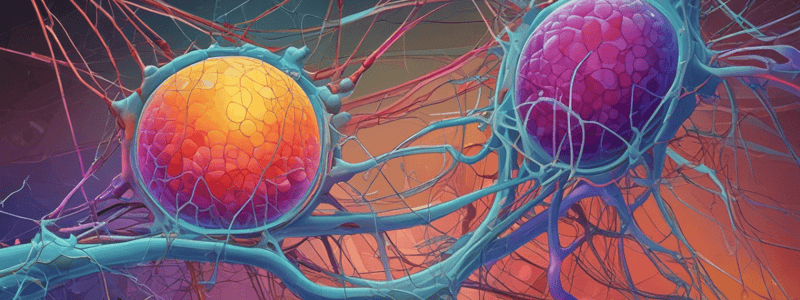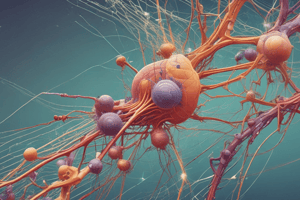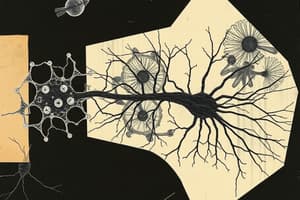Podcast
Questions and Answers
Microtubules are static structures with stable walls composed of polymerized tubulin heterodimers.
Microtubules are static structures with stable walls composed of polymerized tubulin heterodimers.
False (B)
Microfilaments are responsible for providing mechanical stability to cells.
Microfilaments are responsible for providing mechanical stability to cells.
False (B)
Intermediate filaments are the most dynamic component of the cytoskeleton.
Intermediate filaments are the most dynamic component of the cytoskeleton.
False (B)
Inclusions are metabolically active and have a variety of functions within the cell.
Inclusions are metabolically active and have a variety of functions within the cell.
Microtubules are involved in the transport of vesicles and organelles by motor proteins such as kinesin and dynein.
Microtubules are involved in the transport of vesicles and organelles by motor proteins such as kinesin and dynein.
Myosins are motor proteins that move along microtubules carrying vesicles or producing cytoplasmic movement.
Myosins are motor proteins that move along microtubules carrying vesicles or producing cytoplasmic movement.
Intermediate filaments have an average diameter of 20-25 nm.
Intermediate filaments have an average diameter of 20-25 nm.
Cytoskeletal components are only involved in maintaining cell shape and mechanical stability.
Cytoskeletal components are only involved in maintaining cell shape and mechanical stability.
Mitochondria are single membrane-enclosed organelles.
Mitochondria are single membrane-enclosed organelles.
Mitochondrial diseases are a group of genetic conditions that affect how lysosomes produce energy.
Mitochondrial diseases are a group of genetic conditions that affect how lysosomes produce energy.
Microtubules are 5-7 nm in diameter.
Microtubules are 5-7 nm in diameter.
Intermediate filaments are 25 nm in diameter.
Intermediate filaments are 25 nm in diameter.
Cytoskeleton is composed of only two types of polymers.
Cytoskeleton is composed of only two types of polymers.
Mitochondria are responsible for the synthesis of ATP during anaerobic cellular respiration.
Mitochondria are responsible for the synthesis of ATP during anaerobic cellular respiration.
Ribosomes are typically found in the cell membrane
Ribosomes are typically found in the cell membrane
The cytoskeleton determines the shapes of cells and plays an important role in the movement of organelles and cytoplasmic vesicles.
The cytoskeleton determines the shapes of cells and plays an important role in the movement of organelles and cytoplasmic vesicles.
The Endoplasmic Reticulum is a network that extends from the surface of the mitochondria throughout most of the cytoplasm
The Endoplasmic Reticulum is a network that extends from the surface of the mitochondria throughout most of the cytoplasm
Actin filaments are most concentrated at the centrosome area near the nucleus.
Actin filaments are most concentrated at the centrosome area near the nucleus.
The cytoskeleton is responsible for determining a cell's shape and motility
The cytoskeleton is responsible for determining a cell's shape and motility
Ribosomes produce proteins that are incorporated into the cell wall
Ribosomes produce proteins that are incorporated into the cell wall
The Endoplasmic Reticulum is composed of a series of non-intercommunicating channels
The Endoplasmic Reticulum is composed of a series of non-intercommunicating channels
Lysosomes are involved in protein synthesis
Lysosomes are involved in protein synthesis
The Golgi Apparatus is responsible for modifying and packaging proteins for transport out of the cell
The Golgi Apparatus is responsible for modifying and packaging proteins for transport out of the cell
Cytosol contains hundreds of enzymes involved in cellular metabolism
Cytosol contains hundreds of enzymes involved in cellular metabolism
What is the primary function of the Golgi apparatus in protein synthesis?
What is the primary function of the Golgi apparatus in protein synthesis?
Which organelle is responsible for intracellular digestion and turnover of cellular components?
Which organelle is responsible for intracellular digestion and turnover of cellular components?
What is the Endoplasmic Reticulum responsible for, aside from protein synthesis?
What is the Endoplasmic Reticulum responsible for, aside from protein synthesis?
What is the main function of the mitochondria in cellular metabolism?
What is the main function of the mitochondria in cellular metabolism?
What is the primary function of lysosomes in cellular metabolism?
What is the primary function of lysosomes in cellular metabolism?
What is the main component of the cytoskeleton involved in providing mechanical stability to cells?
What is the main component of the cytoskeleton involved in providing mechanical stability to cells?
What is a primary function of microtubules in maintaining cell shape?
What is a primary function of microtubules in maintaining cell shape?
What is a key characteristic of intermediate filaments?
What is a key characteristic of intermediate filaments?
What is the primary function of microfilaments in the cytoskeleton?
What is the primary function of microfilaments in the cytoskeleton?
What is the average diameter of intermediate filaments?
What is the average diameter of intermediate filaments?
What is the role of motor proteins in the cytoskeleton?
What is the role of motor proteins in the cytoskeleton?
What is the primary function of the cytoskeleton?
What is the primary function of the cytoskeleton?
What type of protein subunits make up intermediate filaments?
What type of protein subunits make up intermediate filaments?
What is a key difference between microfilaments and microtubules?
What is a key difference between microfilaments and microtubules?
What is the primary function of microtubules in the cytoskeleton?
What is the primary function of microtubules in the cytoskeleton?
What is the diameter of intermediate filaments?
What is the diameter of intermediate filaments?
What is the function of the cytoskeleton in the cell?
What is the function of the cytoskeleton in the cell?
What is the diameter of microfilaments?
What is the diameter of microfilaments?
What is the role of actin filaments in the cell?
What is the role of actin filaments in the cell?
What is the composition of the cytoskeleton?
What is the composition of the cytoskeleton?
What is the function of microtubules in the transport of vesicles and organelles?
What is the function of microtubules in the transport of vesicles and organelles?
What is the characteristic of microtubules in terms of their diameter?
What is the characteristic of microtubules in terms of their diameter?
Study Notes
Cytoskeleton
- Microtubules: semi-rigid tubular structures composed of polymerized tubulin heterodimers, dynamic with steady addition and dissociation of tubulin.
- Microtubules are important for maintaining cell shape and as tracks for transport of vesicles and organelles by motor proteins kinesin and dynein.
Microfilaments
- Short, flexible, highly dynamic filaments of actin subunits.
- Changes in length and interactions with binding proteins regulate cytoplasmic viscosity and movement.
- Myosins are motor proteins that bind and move along actin filaments, carrying vesicles or producing cytoplasmic movement.
Intermediate Filaments
- Most stable cytoskeletal component, conferring strong mechanical stability to cells.
- Composed of various protein subunits in different cells, including vimentin, nuclear lamins, neurofilament proteins, and keratins.
- Average diameter of 8-10 nm, between that of actin filaments and microtubules.
Inclusions
- Not metabolically active, primarily storage sites, such as lipid droplets, glycogen granules, pigment granules, or residual bodies (also called lipofuscin).
Mitochondria
- Double membrane-enclosed organelles with arrays of enzymes specialized for aerobic respiration and production of ATP.
- Synthesize most ATP during aerobic cellular respiration by digestion of fuel molecules in the presence of oxygen.
- Mitochondrial diseases are a group of genetic conditions that affect how mitochondria produce energy.
Cytoplasmic Organelles
- Metabolically active structures inside the cell membrane, such as mitochondria, ribosomes, and proteasomes.
- Positioned in the cytoplasm by movements along the polymers of the cytoskeleton, which also determines a cell's shape and motility.
Ribosomes
- Macromolecular machines that assemble polypeptides from amino acids on molecules of transfer RNA (tRNA) in a sequence specified by mRNA.
- Functional ribosome has two subunits of different sizes bound to a strand of mRNA.
- Engage in protein synthesis, with bound ribosomes producing proteins that are secreted or incorporated into the plasma membrane.
Endoplasmic Reticulum
- Convoluted membranous network that extends from the surface of the nucleus throughout most of the cytoplasm.
- Encloses a series of intercommunicating channels called cisternae (reservoirs).
Endoplasmic Reticulum
- ER is a major site for vital cellular activities, including biosynthesis of proteins and lipids.
- Responsible for various cellular activities.
Golgi Apparatus
- Completes posttranslational modifications of proteins produced in the RER.
- Packages and addresses proteins to their proper destinations.
- Consists of many smooth membranous saccules, containing enzymes and proteins being processed.
- Named after histologist Camillo Golgi who discovered it in 1898.
Lysosomes
- Sites of intracellular digestion and turnover of cellular components.
- Spherical-shaped membrane-bound organelles formed from the Golgi apparatus.
- Contain about 40 different hydrolytic enzymes.
- Particularly abundant in cells with great phagocytic activity (e.g., macrophages, neutrophils).
- Digest microbes or materials, including ingested by the cell, worn out cellular components, or the entire cell.
Mitochondria
- Double membrane-enclosed organelles with arrays of enzymes specialized for aerobic respiration and production of ATP.
- Synthesize most ATP during aerobic cellular respiration by digestion of fuel molecules (e.g., glucose) in the presence of oxygen.
- Mitochondrial diseases are a group of genetic conditions that affect how mitochondria in the cells produce energy.
- Can affect almost any part of the body, including cells of the brain, nerves, muscles, kidney, heart, liver, eyes, pancreas, etc.
Cytoskeleton
- A complex array of microtubules, microfilaments (also called actin filaments), and intermediate filaments.
- Determines the shapes of cells, plays an important role in the movements of organelles and cytoplasmic vesicles, and allows the movement of entire cells.
- Microtubules and actin microfilaments can be clearly distinguished by TEM.
- Immunocytochemistry using antibodies against their subunit proteins can demonstrate arrays of microfilaments and microtubules.
- Actin filaments are most concentrated at the cell periphery.
- Microtubules are oriented in arrays that generally extend from the centrosome area near the nucleus into the most peripheral.
Microtubules
- Semi-rigid tubular structures with walls composed of polymerized tubulin heterodimers.
- Structure is often very dynamic, with steady addition and dissociation of tubulin.
- Important in maintaining cell shape and as tracks for transport of vesicles and organelles by the motor proteins kinesin and dynein.
- Diameter of 25 nm.
Microfilaments
- Short, flexible, highly dynamic filaments of actin subunits.
- Changes in length and interactions with binding proteins regulate cytoplasmic viscosity and movement.
- Myosins are motor proteins that bind and move along actin filaments, carrying vesicles or producing cytoplasmic movement.
- Diameter of 5-7 nm.
Intermediate Filaments
- The most stable cytoskeletal component, conferring strong mechanical stability to cells.
- Composed of various protein subunits in different cells, including vimentin, nuclear lamins, neurofilament proteins, and keratins.
- Display an average diameter of 8-10 nm, between that of actin filaments and microtubules.
- Serve to provide mechanical strength or stability to cells.
Inclusions
- Not metabolically active and are primarily storage sites.
- Examples include lipid droplets, glycogen granules, pigment granules, or residual bodies (also called lipofuscin).
Studying That Suits You
Use AI to generate personalized quizzes and flashcards to suit your learning preferences.
Related Documents
Description
Learn about the structure, function, and importance of microtubules and microfilaments in cells, including their composition, dynamics, and roles in cell shape and transport.




